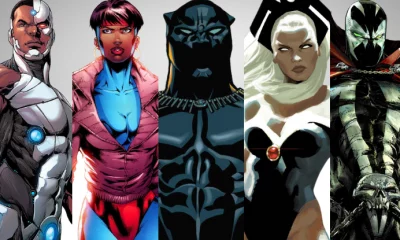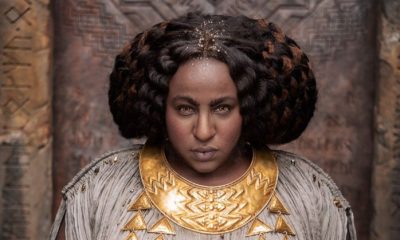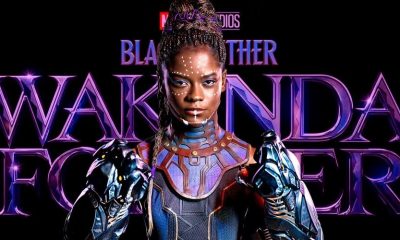BOOKS
Africanfuturista! The fantastical adventures of Nnedi Okorafor
Published
2 years agoon
By
Geek Afrique
Starting out with a small handful of sci-fi and fantasy short stories and novellas, Nnedi Okorafor’s legend – and bibliography – has grown. With a good number of successful books, the Nigerian-American writer’s work continues to attract readers to Africanfuturism, a fast-growing genre. And with a well-received foray into comic books for Marvel, DC, Dark Horse, and even IDW, she has cemented her place in the collective hearts of geekdom.
By Abdulkareem Baba Aminu
Spaceships, terrorist aliens, water spirits, soldiers, Boko Haram, and wet piles of meat. These aren’t part of a kind of dark poetry, but mainstays of some of the best work of writer Nnedi Okorafor. Her work in her genre of choice Africanfuturism (one word, no space), her speculative fiction and fantasy work, are among the most unique today. Africanfuturism, which Okorafor coined, is an exciting subgenre that welds science fiction and technology to African mythologies, weaving black people —or blackness, really— into fertile worlds rife with story possibilities.
Back to Okorafor, she was 19 when she began to write stories, from a hospital bed, paralyzed from spinal surgery complications. She never stopped, getting published for the first time in 1999, a short story called ‘Uche’ for an international women’s online journal whose name she forgets. But she remembers that “It was cool.” Now 48, she says: “I don’t write to get published, I write because I like writing, so it felt right.”
“I don’t write to get published, I write because I like writing, so it felt right.”

When asked what early influences might have nudged her towards sci-fi and fantasy, Okorafor recalled moments in Nigeria where she noticed the coexistence of traditional ways and technology. “I realized that I wasn’t seeing this side of Africa as a whole in the stories I was reading, or the books I was seeing published,” she says.
Okorafor has a number of times cited Nigeria as her muse, and she says that’s because she is Nigerian, and identifies with that. “That’s how it works,” she adds, “My parents have been taking my siblings and me there since we were very young.” On those trips, they would first stay in Lagos, which is very urban, then for the second part of the trip, off they’d go to her parents’ villages in the South-East.
Okorafor describes those trips as ‘epic’. “For all of us, in wonderful and terrible and magical ways. They got under my skin. When I wrote my very first piece of fiction, it was no surprise that it was set in Nigeria. Whenever I visit, I naturally inhale stories.”
“When I wrote my very first piece of fiction, it was no surprise that it was set in Nigeria. Whenever I visit, I naturally inhale stories.”

Okorafor tweeted in August 2017, that publisher Marvel’s anthology comic book, ‘VenomVerse: War Stories’, would feature an 8-page story she’s written. The internet, as it tends to often do, broke in two, but with excitement. Drawn by Tana Ford (with whom Okorafor would later collaborate on the Eisner-winning ‘LaGuardia’ at Dark Horse), the story featured Black Panther, The Rhino, and Venom, and it also introduced a Nigerian character – one of few at the big publisher – called Ngozi. In the short tale, she served a deft, future shock-style twist ending which left readers wanting more.
Marvel heeded, handing their main black character to her to write, in a digital-only series titled ‘Black Panther: Long Live The King’ that was a hit with readers and critics alike. Drawn by André Lima Araújo, whose gorgeous line work helped weave Okorafor’s world-building words out in a sprawling, visual feast that’s fit for royalty, it was followed by ‘Wakanda Forever’, a miniseries that saw her play in a full Marvel sandbox, writing stories involving the publisher’s most iconic characters like Spider-Man, the X-Men, and many others.
Marvel heeded, handing their main black character to her to write, in a digital-only series titled ‘Black Panther: Long Live The King’ that was a hit with readers and critics alike.

But hold up: the Wakandan king’s book isn’t Okorafor’s first comic book rodeo. “That was in 2012, for DC/Vertigo, for an anthology called ‘Mystery in Space’. My story was called ‘The Elgort’, illustrated by Michael Kaluta,” she says. The ‘VenomVerse: War Stories’ tale happened when Marvel asked her to write Black Panther. “After two weeks of thought, I said ‘Yes!’ We’d discussed me writing some other character before this, but Black Panther was the one I felt I could do the most justice to,” she tells me. For research, Okorafor jumped into the stories written by writers Ta-Nehisi Coates, and Roxanne Gay, as well as some of the very first Black Panther comics (about which she said ‘Heh, those were interesting.’)
Okorafor also ended up having to research quantum physics and biotech, and she took a closer look at the fictional metal vibranium, as well as the properties of meteors. “It was a lot,” she said. The research paid off, making ‘Long Live the King’ read very believably, even at its most fantastical.
The writer has been reading comics since she was a child. “I read them mainly in the newspaper, and was so obsessed with them that I would collect pages and pages,” she says. “As a kid, it was more the medium of it, the shape of lines, the containment of text, the narrative relationship between text and image. I’d stare and stare at the pages and I couldn’t quite understand why. I stared at Garfield for so long once, maybe for over two hours, that to this day I can still draw his face perfectly.”
The writer has been reading comics since she was a child. “I read them mainly in the newspaper, and was so obsessed with them that I would collect pages and pages.”

It is quite possible that her fondness for Garfield sparked a love the writer has for felines. She currently has two striking cats called Periwinkle Chukwu (soon to be the star of his own graphic novel called ‘Space Cat’, written by Okorafor and drawn by Ford) and Neptune Onyedike, both of them with quite the social media presence. So it’s no surprise that one of her three favourite comic books include the pet-centric ‘We3’ (“Grant Morrison is my favorite comics writer,” she says), which she also confesses is the first comic to make her cry. Okorafor’s other faves include ‘Wonder Woman’ (“Gail Simone’s run portrayed the unapologetic Wonder Woman I’ve always wanted to see”), and ‘Y: The Last Man’ (“Brian K. Vaughn’s work there is excellent storytelling”).
With a well-received, if inevitable, return to writing comic books, and with Black Panther under her belt, Okorafor was asked which other Marvel or DC characters she would like to tackle. “Vixen. Maybe Storm,” she says.
It is quite possible that her fondness for Garfield sparked a love the writer has for felines. She currently has two striking cats called Periwinkle Chukwu (soon to be the star of his own graphic novel called ‘Space Cat’, written by Okorafor and drawn by Ford) and Neptune Onyedike, both of them with quite the social media presence.

Okorafor finds writing comic books very different from writing novels. “Comics are a visual medium, and I have to come at them in this way. The first phase of scripting for me is by hand, and sometimes I even sketch the individual panels. At the same time, when I write prose, I’m also very visual, so moving back and forth between the mediums isn’t as jarring as it might be for other novelists. And dealing with the visual medium of film has also helped me. I feel like I’m becoming fluent in multiple languages from various language families.”
Back again to her own creations, Okorafor’s ‘Binti’ won both the 2016 Nebula Award and 2016 Hugo Award for Best Novella, while ‘Who Fears Death’, which won the 2011 World Fantasy Award for Best Novel, is being turned into a highly-anticipated HBO series, adapted by ‘Game Of Thrones’ writer George R.R Martin.
Okorafor finds writing comic books very different from writing novels. “Comics are a visual medium, and I have to come at them in this way.”

Okorafor has a breath-taking oeuvre of work and is making a transition to TV pretty well, with several projects being developed at the same time. There’s a good number of her books out now, including the heartfelt YA ‘Ikenga’, the striking Africanfuturist ‘Remote Control’, and the absolutely brilliant ‘Noor’, a welcome return to adult sci-fi (yay!). And any true fan knows there will be more out any minute from now. That, however, is when it comes to books. But does Okorafor like writing comic books enough to stay? “Yes,” she answered. And the resounding cheers of her legion of fans could be heard around geekdom, mine included.
A version of this article was first published in Full Bleed Vol. 2 (IDW Publishing), in 2018. It has been updated to include recent information and perspectives.

BOOKS
Nommo Awards 2024: And the nominees are…
Published
1 month agoon
June 13, 2024By
Geek Afrique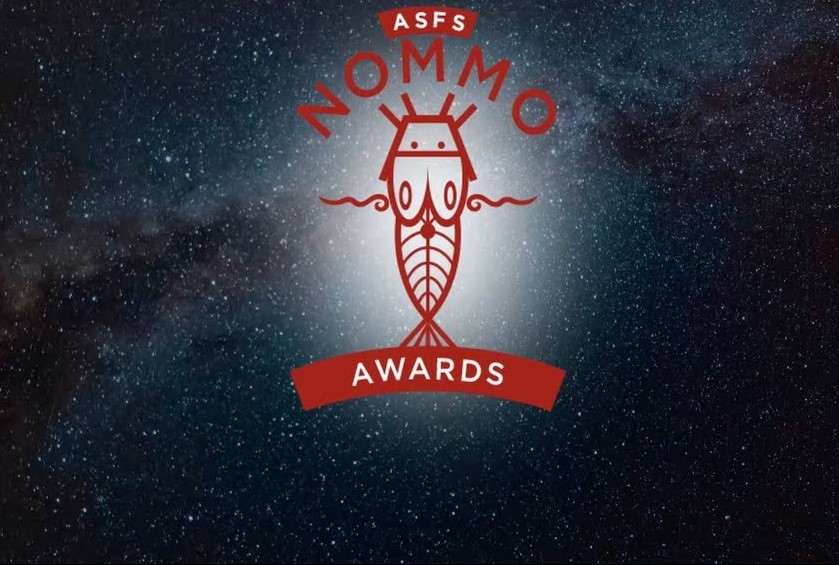
The shortlist for the African Speculative Fiction Society’s Nommo Awards 2024 was announced on Wednesday, June 12, 2024. The Nommo Awards celebrate science fiction, fantasy, and speculative fiction. Since 2016, the event has been an annual affair celebrating writers in the categories of Best Speculative Novel by an African, Best Speculative Novella by an African, Best Speculative Short Story by an African, and Best Graphic Novel/Comic by an African.
Nommo laurels have been clinched by Nnedi Okorafor, Tade Thompson, Akwaeke Emezi, Tochi Onyebuchi, Lesley Nneka Arimah, Nana Akosua Hanson, Ekpeki Oghenechovwe Donald, Innocent Chizaram Ilo, Suyi Davies Okungbowa, Wole Talabi, Nerine Dorman, T. L. Huchu, Pemi Aguda, among others.
The shortlist for the 2024 edition is as follows:
Novel
Bones and Runes, Stephen Embleton (Abibiman Publishing, 2022)
Dazzling, Chikodili Emelumadu (Hachette; Wildifre, Headline Publishing Group, 2023)
Don’t Answer when They Call Your Name, Ukamaka Olisakwe (Masobe Books, 2023)
Shigidi and the Brass Head of Olabufon, Wole Talabi (Gollancz and DAW Books, 2023)
Vagabonds!, Eloghosa Osunde (Harper Collins; 4th Estate and Riverhead Books, 2022)
Warrior of the Wind, Suyi Davies Okungbowa (Orbit Books, 2023)
Novella
Broken Paradise, Eugen Bacon (Luna Press Publishing, 2023)
Land of the Awaiting Birth, Oghenechovwe Donald Ekpeki and Joshua Uchenna Omenga (from Between Dystopias: The Road to Afropantheology, SF & Fantasy, 2023)
The Lies of the Ajungo, Moses Ose Utomi (Tordotcom/Masobe, 2023)
Undulation, Stephen Embleton (from Mothersound: The Sauútiverse Anthology, 2023)
Short Story
A Name is a Plea and a Prophecy, Gabrielle Emem Harry (Strange Horizons 14 August, 2023)
Blackwater Children, Moustapha Mbacké Diop (Haven Speculative Fiction, Issue 7, Nov 2022)
Destiny Delayed, Oghenechovwe Donald Ekpeki (Asimov’s Science Fiction, Vol 46, May/June, 2022) Kɛrozin Lamp Kurfi by Victor Forna (Apex Magazine, 2023)
Like Stars Daring to Shine, Somto Ihezue (Fireside Fiction, July 2022)
Loom, Solomon Uhiara (Dark Matter Magazine No. 8, 2022)
My Mother’s Love, Naomi Eselojor (Hexagon Issue 10 / Fall, 2022)
Osimiri, Chinaza Eziaghighala (Fission #2: Volume 1, An Anthology of Stories from the British Science Fiction Association, BSFA & HWS Press, 2022)
The Way of Baa’gh, Cheryl S. Ntumy (Mothersound: The Sauútiverse Anthology, Android Press, 2023)
Graphic Novel
Die Strandloper, Daniël Hugo (Dream Press & Daniël Hugo, 2022)
Grimm’s Assistant, Mamode Ogbewele (Mode Comics, 2023)
WindMaker volume 1, Roye Okupe, Sunkanmi Akinboye, Toyin Ajetunmobi and Godwin Akpan (Dark Horse Comics, 2022)
The winners will be announced at a yet-to-be-disclosed venue and date.
BOOKS
#BookChaser: Why I hated reading Iruesiri Samson’s ‘Devil’s Pawn’
Published
1 year agoon
March 3, 2023By
Geek Afrique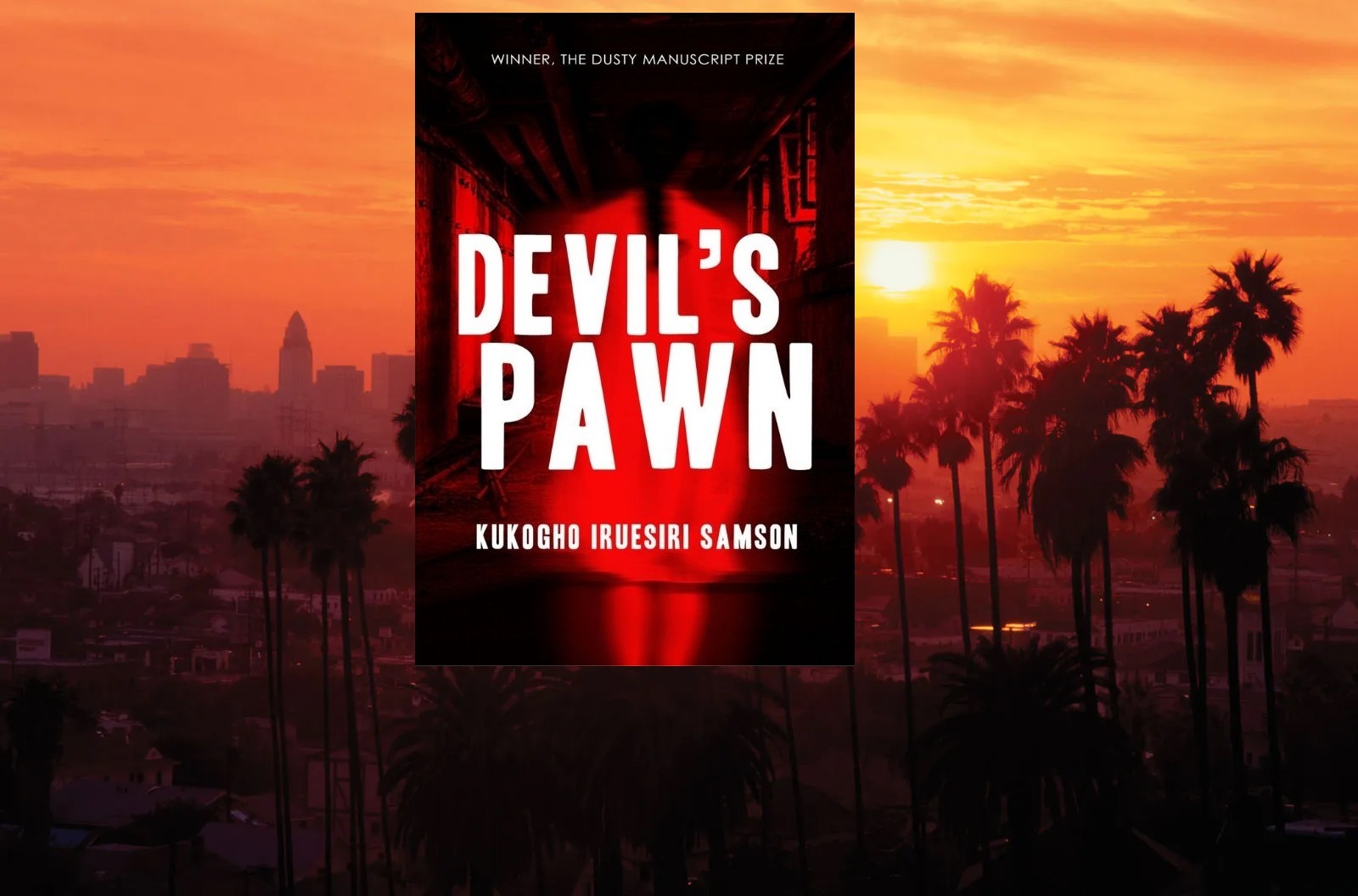
Nathaniel Bivan
I hated reading Devil’s Pawn, and you probably would if you were male. I mean, the male genital was mentioned, probably a hundred times and I kept shivering at the prospect of yet another victim of Simon, the genital hunter, cutting off another. But, you see, Simon’s hunt doesn’t begin without reason. This reason was a bloody crime that made me cringe and almost scream, yes! That the culprits deserve it. But before you wonder what I am rambling about, let me give you some background to this crime thriller that made me think of Agatha Christie and James Hadley Chase, all at once.
When the Black Cats, a university cult group, headed by Emeka decided to punish Ese for refusing the latter’s advances, they never envisioned the bloodier outcome. Yes, they gang-raped her before they murdered her (well, technically, Simon was forced to do it). But little did they know that this wild move would mark them all for hell, one by one, in the most shocking manner.
Now, for me, this is what made me fall in love with the novel – the twist. From a should-have-been cult story to a ‘Hammer House of Horror’ episode where all those involved in Ese’s death are marked for death. Obviously, the author, Kukogho Iruesiri Samson, who won the 2018 Dusty Manuscript Prize for this work is a writer who pays attention to detail. This is evident all through. Published in 2020, I would have normally read this book in the same year, but doing it now, in a way, makes the suspense even more worthwhile. And I am glad I finally did.
Again, twists in plots have always been my thing because I’m not too fond of this ability to know what would come next in the best of stories. So, when I fail to spot the direction, it’s always a joy for me. If I am to venture into the author’s mind a little, I am almost certain the advocation for the castration of rapists at a time in Nigeria inspired this twist. I mean, what better way to illustrate déjà vu than to have one of the culprits be the dead victim’s cutting tool?
I have heard some writers like Toni Kan say in a panel discussion (this was at the Kaduna Book and Arts Festival some years back) that he doesn’t write to pass across a message. But just like I see the scary warning given to rapists in ‘Devil’s Pawn’, I see different messages in practically every work of fiction. For me, the message, whether consciously thought out or not, is what drives the writer, and maybe even the narrative.
Let me give an example: If we are to go out and be all moral about this, even a story that’s characterized as erotica has a purpose. And if the aim is to appeal to readers who appreciate graphic sex, then yes, that’s the message. Every character has a purpose in a work of art, and with this purpose rises a message, whether clear or not, whether a turn-off to some or a joy to others. Samson’s debut novel has the capacity to scare the devil out of any rapist, particularly in this part of Africa where superstitious beliefs are upheld by some.
One thing, though that ‘Devil’s Pawn’ lacks, is excellent proofreading. The editing is excellent, but an equally excellent proofreader would have cleared numerous typos. But still, who says a good book is that which is rid of typos? The best, for me, are those stories that have staying power, driven by suspense and empathy. And this brilliant novel has both.
BOOKS
#AkumbuReviews: Children of the Quicksands by Efua Traoré
Published
1 year agoon
February 7, 2023By
Geek Afrique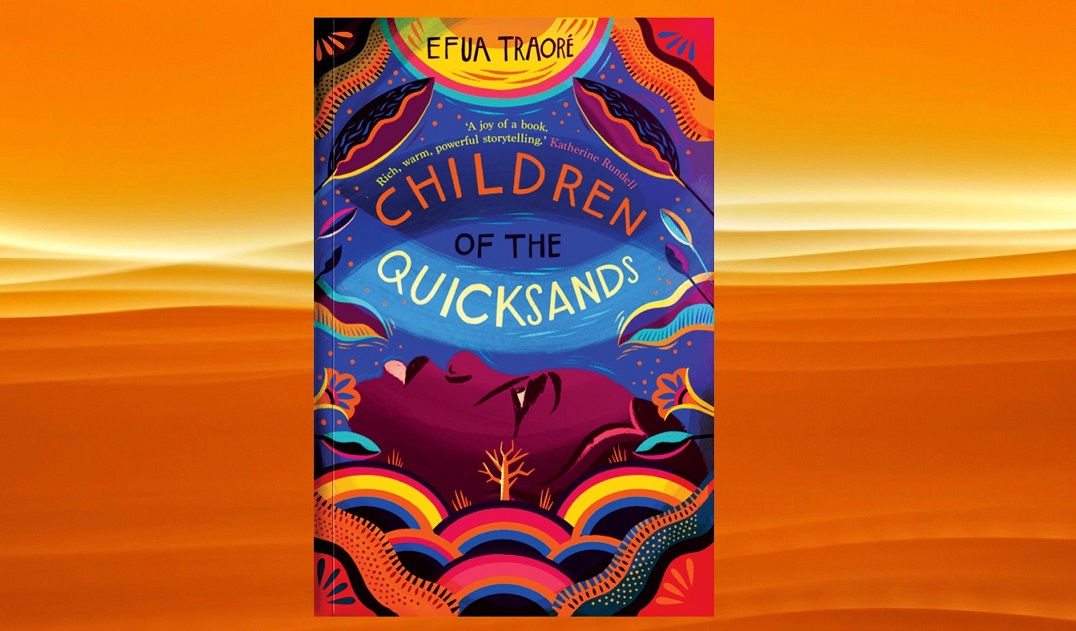
Our reviewer takes a look at a book that weaves old-school folktale-telling and contemporary themes for a story unlike any other on the bookshelves today.
Akumbu Uche
A few months ago, I was surprised to learn that a young friend had never heard about the NTA children’s programme, ‘Tales by Moonlight’. Growing up in the nineties, no Sunday evening was complete without switching on the TV to watch Aunty Nkem (Pastor Nkem Oselloka-Orakwue), the show’s host, gather a gaggle of children underneath a tree and regale them with folktales. As I worried aloud that my friend had been starved of what I considered a childhood staple and bemoaned how Nigerian society had lost a vital means of transferring cultural values and mores, I suddenly wondered what my parents and grandparents who, in their youth, had experienced the real, authentic moonlit tales in their villages, must have made of my own mediated and somewhat diluted experience.
Reading ‘Children of the Quicksands’ (Masobe Books, 2022) by Efua Traoré reminded me of this incident and reassured me that all is not lost; there are still avenues where today’s young people can enjoy learning about the same myths and folklore I grew up on.
The middle-grade novel opens as thirteen-year-old Simi is dispatched to her maternal village, Ajao, to spend the holiday with Iya, her grandmother. Her mother has had to leave for a work trip abroad and can’t take her along. Thanks to a long-running family feud, Simi and Iya are strangers to each other. To make matters worse, Simi is an aje butter. City living, coupled with her mother’s helicopter parenting, has ill-prepared her for building a fire, cleaning ofada rice, or hand-washing clothes at the stream, skills that her village-raised peers take for granted. Fortunately, Simi finds new friends in Jay, the Oba’s cool and fashion-forward son, and Bubu, a shy girl who, in her rare talkative moments, tells stories about bush babies and pythons spiriting erring villagers away at night; and she soon learns to adapt to rural life.
However, bush babies and pythons aren’t the only dangers lurking in Ajao. In the middle of the forest is a forbidden lake reputed to be a portal to a netherworld and responsible for the disappearance of several children.
However, bush babies and pythons aren’t the only dangers lurking in Ajao. In the middle of the forest is a forbidden lake reputed to be a portal to a netherworld and responsible for the disappearance of several children. Simi accidentally discovers that she is the only one who can go in and out of the lake, unscathed; a power that may very well be related to Iya’s vocation as a priestess to the goddess Oshun. But while she is still figuring out this secret magical ability and its implications, she and her friends discover the townspeople’s plans to landfill the lake; a move that could have devastating consequences. Intended or not, I couldn’t help but see parallels between this subplot and the recent controversy surrounding the pollution of Nigeria’s sacred Osun river due to mining activities. For parents and educators, this could open up a great way of engaging young readers in discussions on ecological conservation and environmental justice issues.
The backstory about how the goddess Oshun created the quicksands – a netherworld between the land of the living and the land of the dead – which then sets off the chain of events in this tale is an intriguing one. Traoré does an excellent job blending preexisting folklore with her own original inventions, making the story all her own and making it easy to see why she won the Times/Chicken House Children’s Fiction Competition in 2019, a winning streak that began a year earlier, when she won the 2018 Commonwealth Africa prize with her short story, ‘True Happiness.’ Her grasp of dialogue is excellent too. Each character has their own distinct speech pattern; a detail which she employs to flesh out supporting characters whose treatment could have felt tropey and cliched in the hands of a less confident writer.
Each character has their own distinct speech pattern; a detail which she employs to flesh out supporting characters whose treatment could have felt tropey and cliched in the hands of a less confident writer.
‘Children of the Quicksands’ may be billed as fantasy and magical realism, but the novel demonstrates that the traditional African worldview treats the supernatural as an extension of reality, and the author goes to great lengths to show that the Yoruba Ifásystemis not just a set of superstitious beliefs but a legitimate faith with its own logic. Of this, only a few may be persuaded because, as Joseph Campbell observed in his seminal work, ‘The Power of Myth’, the hard facts of one religion are likely to be dismissed as myths by another. However, myths offer universal messages, and in a time when there is increased antagonism between adherents of adopted Abrahamic faiths and those of African traditional religions, the novel’s subtle but emphatic stress on religious tolerance and peaceful coexistence is a timely message.
With other themes like familial relationships, reconciliation, and bravery, the novel covers a lot of moral ground and offers impressionable minds many valuable lessons. Much like an onion being peeled, ‘Children of the Quicksands’ guarantees the discovery of a new layer each time it’s reread.







